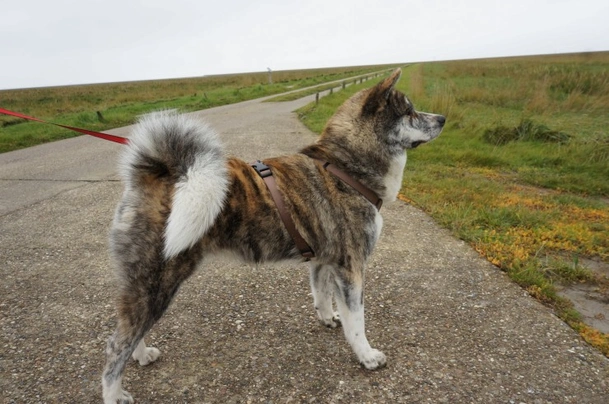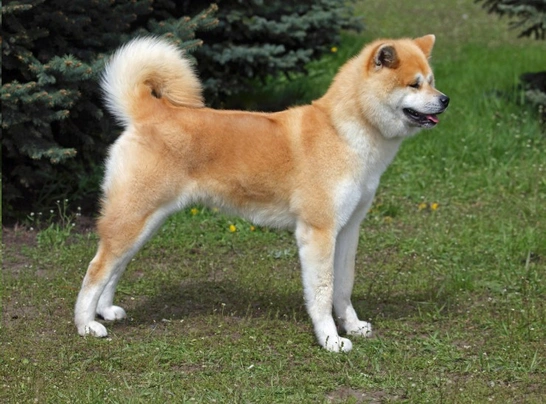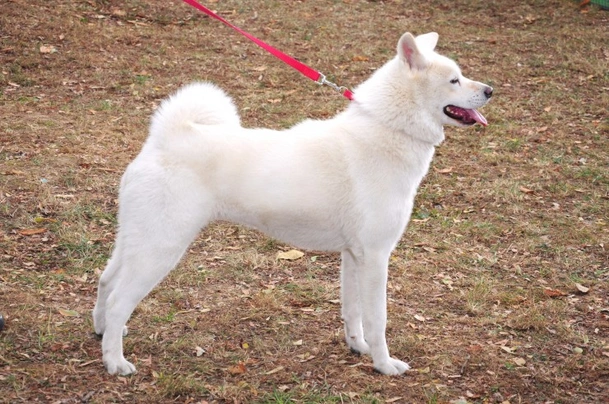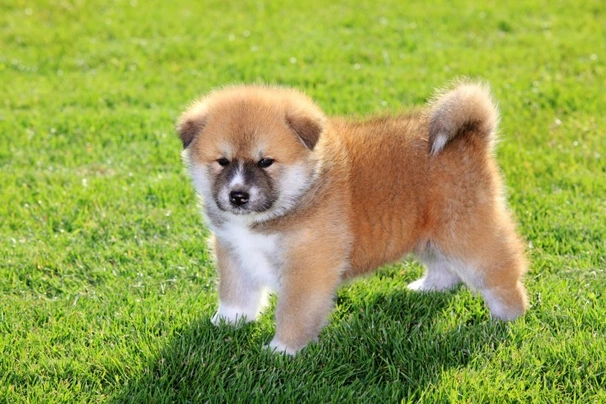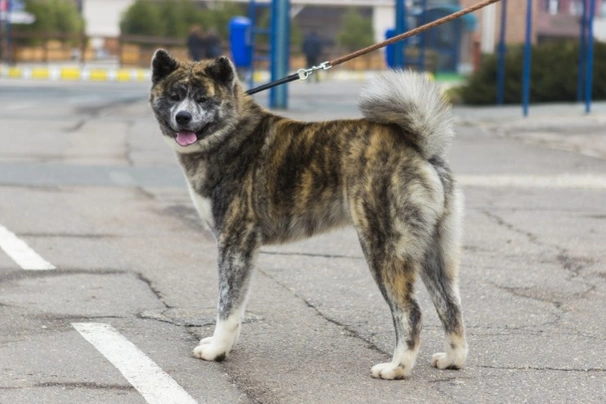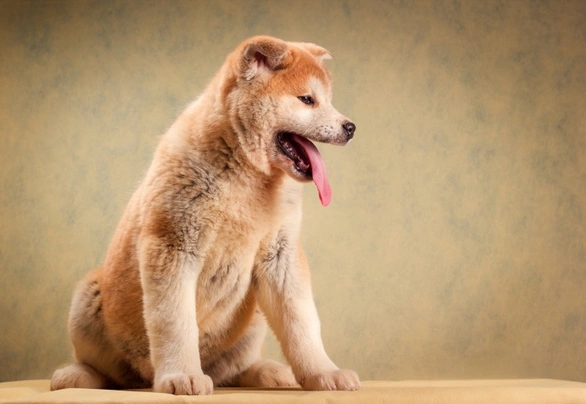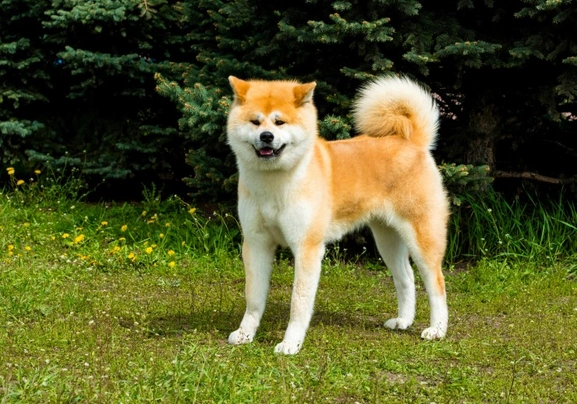Japanese Akita Inu
Pros
Cons
Introduction of the Japanese Akita Inu
The Japanese Akita Inu is a Spitz-type dog that originates from the most northern mountain regions of mainland Japan. There are in fact two types being the American Akita and the Japanese Akita Inu with dogs being differentiated by their coat colours. Both are powerful large dogs that command a lot of presence no matter where they are.
The Japanese Akita Inu is not the sort of dog that would suit everyone and they are not a good choice for first time owners because they need to be trained and handled by people who are familiar with the needs and character of such a large and dominant dog. Their training and socialisation must start early and their education must continue to be consistent throughout a dog's life so they understand not only their place in the pack but what an owner expects of them. The Japanese Akita Inu is best suited to people who have ultra-secure back gardens bearing in mind that they are extremely good escape artists that boast a very high prey drive.
History of the Japanese Akita Inu
Many people believe that many dogs were introduced to Japan at a time when the continents were not separated by the Sea of Japan. It was a time when people moved between Europe and the Far East taking their dogs with them and paw prints belonging to dogs were discovered in Japanese pit houses date back 3000 years. It was also found that dog bones were discovered in graves that date back to the era. With this said the Japanese Akita Inu is native to a region of Japan known as Tohoku which is in the most northerly region of the country. The area consists of 6 "prefectures" one of which is known as Akita.
Interestingly the city of Odate in the region of Akita has always been referred to as being a "dog town" and the breed was known by many other names during this period of history namely "Kazuno-Inu and Odate-Inu" which are both areas of the northern Akita prefecture although they were also called "Nambu-Inu" which was the name of the region during the Han period which dates from 202 BC to 16 AD. At the time the breed used as fighting dogs in towns whereas in the country they were used for hunting in the mountainous regions. Wealthier people also kept Akitas as guard dogs.
Japanese history credits the ancient Matagi as the foundation dog for the Akita breed. They are one of the country's oldest native dogs that were originally bed to hunt large game which included deer wild boar and bears. There are some people who believe the Akita might have European and Asian dogs in their ancestry and this includes Mastiffs Great Danes and the Tosa Inu. These dogs were introduced into the mix to create a courageous fighting dog. However breed numbers fell during World War II when many Akitas were culled by the military and to prevent diseases from spreading. Many dogs were also eaten by their owners because of the lack of food during the war years. Their numbers fell so low that German Shepherds were introduced into the breed with an end goal being to guarantee the Akita’s future.
One of the main breed enthusiasts was Helen Keller an author humanitarian and lecturer who it is thought was the first person to take Akitas to the United States. In 1937 she was studying physically handicapped people in Japan being deaf and blind herself. She was told the story of a dog called Hachi-ko and wanted to meet an Akita. A gentleman named Mr. Ogasawara introduced her to a 2-month-old puppy which she fell in love with straight away.
The puppy's name was Kamikaze-go and he was given to Keller as a gift. She took her puppy back to the States with her but sadly he died just 1 month later of distemper. Miss Keller was then sent a second Akita a dog called Kenzan-go that was Kamikaze-go's brother. Kenzan-go was to become Miss Keller's "Angel in Fur" and he remained her close companion right up until his death.
In 1931 the Akita was declared Japan's national dogs and further efforts were made to restore breed numbers. Thanks to careful and selective breeding this led to a breed standard being established in 1934 to ensure the purity of these proud and noble dogs. With this said many breed enthusiasts believe that the Japanese Akita Inu is a descendent of dogs that originate from the Akita Iwate and Yamagata prefectures of Japan called the Matagi-inu. In 2006 the Japanese Akita Inu was recognised as a breed in the UK and it is thought they are the closest to the original breed with only four coat colours being accepted under the very strict breed standard as set out by the Kennel Club.
Interesting facts about the breed
- Is the Japanese Akita Inu a vulnerable breed? No they are among some of the more popular dogs in the UK and elsewhere in the world
- Akitas have webbed toes which helps them walk on snow more easily
- They adore the colder weather and enjoy playing in the snow
- They are Japan's national dog and are considered a "national treasure"
- When babies are born in Japan families are given a small statue depicting an Akita which is thought to bring long life happiness and health to the child
- Japanese Akitas like to keep themselves clean and will wash themselves much like a cat
Appearance of the Japanese Akita Inu
Height at the withers: Males 63 - 68 cm Females 58 - 63 cm
Average weight: Males 34 - 54 kg Females 34 - 50 kg
The Japanese Akita Inu is a well-balanced large dog and one that boasts having a sturdy solid build. These Spitz-type dogs are slightly longer than they are tall and have dark eyes which all adds to a dog's unique and distinctive look. Their heads seem round when seen from the front thanks to a dog’s well-muscled cheeks. Their skulls are broad and quite flat with no wrinkles. They have a very clearly defined stop and a distinct and charming furrow. Their muzzles have a good depth being straight but tapering gradually to a dog's large black nose. White coated dogs usually have flesh coloured noses which is acceptable in their breed standard. Lips are tight and have a dark pigmentation.
The Akita Inu's eyes are set moderately apart being quite small and almond shaped. Eyes are a dark brown and set obliquely on a dog's face with the rims being tight and dark. Their ears are thick being slightly hooded and triangular with rounded tips. They are set moderately apart which dogs carry pricked and facing forward. The Akita Inu has a strong jaw with a perfect scissor bite where their upper teeth neatly overlap their lower ones. Necks are thick and very muscular being moderately long without any dewlap. They have a pronounced crest that blends in with the back of a dog's skull.
Shoulders are quite well laid back with well-developed muscles. Their front legs are nicely boned and straight when seen from the front. Female Akita Inus have slightly longer bodies than their male counterparts but both male and female dogs have strong level backs and deep chests with nicely developed forechests. Ribs are moderately sprung with dogs having a well-defined tuck up and broad well-muscled loins. Back legs are powerful and muscular with nicely developed thighs and feet are round well arched and tight with firm thick paw pads. Tails are set high being thick and full which dogs carry tightly curled over their backs.
When it comes to their coat the Japanese Akita Inu boasts having a double coat that consists of a course straight outer coat that stands well off the body which is longer at the withers and rump as well as being more profuse on a dog's tail and a much softer dense undercoat that provides dogs with a lot of protection from the elements. They do not have any feathering or hint of a ruff around their necks whatsoever. The four accepted breed colours for Kennel Club registration are as follows:
- Brindle
- Red Fawn
- Sesame
- White
Gait/movement
When a Japanese Akita Inu moves they do so with great purpose taking moderately long strides that show a rhythmic gait and covering a lot of ground as they do.
Faults
The Kennel Club frowns on any exaggerations or departures from the breed standard and would judge the faults on how much they affect a dog's overall health and wellbeing as well as their ability to perform.
Males should have both testicles fully descended into their scrotums and it is worth noting that a dog can be a little lighter or heavier as well as slightly taller or shorter than set out in the Kennel Club breed standard which is given as a guideline only.
Temperament of the Japanese Akita Inu
The Akita Inu is a very dignified dog both in looks and character but they are not the best choice for everyone including first time owners. With this said these noble large dogs form strong bonds with their owners and families but they retain an independent side to their nature which can often border on them being quite stubborn. As such they need to be handled with a firm yet gentle hand so they understand their place in the pack and who is the alpha dog in a household. This is crucial to an Akita Inu's training because if they are allowed they will take on the role simply because it is in their nature to be dominant.
They are known to be extremely clean dogs and can at times be quite cat-like in their cleaning habits which sees dogs washing their faces with their paws. Although they are affectionate and loyal to their immediate family the Akita Inu tends to be a little reserved around people they don't know which can see them becoming territorial and showing a more aggressive side to their characters.
Although they are thought to have an affinity with children their sheer size alone means they are not the best choice for families with toddlers being better suited to households where the children are older and who therefore know how to behave around such a large dog.
Are they a good choice for first time owners?
The Japanese Akita Inu is not a good choice for first time dog owners because they need to be trained and handled by people who are familiar with the specific needs of these energetic smart dogs. If not well socialised and trained correctly from a young enough age a Japanese Akita could quickly get the better of an owner making them that much harder to live with.
What about prey drive?
The Japanese Akita has a very high prey drive and therefore care must be taken when they are around any smaller animals and pets. In short any contact is best avoided and Japanese Akitas need to be kept on the lead when out on a walk anywhere near livestock or other animals.
What about playfulness?
Japanese Akitas have a very playful side to their natures and love to entertain and be entertained. They are known to be very quick and rather mischievous when the mood takes them and being so clever a dog quickly learns how to open a cupboard door to get at any treats that might be in there.
What about adaptability?
Japanese Akitas are better suited to people who have ultra-secure back gardens with extra high fencing to keep these highly skilled escape artists in. As such they are not the best choice for people who live in apartments.
What about separation anxiety?
Japanese Akitas form strong ties with their families but they don't mind being left on their on providing it is never for too long. A bored Japanese Akita can get up to all sorts of mischief which includes keeping themselves entertained by destroying items around the house.
What about excessive barking?
The Japanese Akita seldom barks unless it is for good reason although they do like to "howl" when the mood takes them and most dogs have a lovely singing voice.
Do Japanese Akita Inus like water?
Some Japanese Akitas love swimming and will take to the water whenever they can more especially when the weather is hot. However if anyone who owns a dog that does not like water should never force them to go in because it would just end up scaring them. With this said care should always be taken when walking a Japanese off the lead anywhere near more dangerous watercourses just in case a dog decides to leap in and then needs rescuing because they can't get out of the water on their own.
Are Japanese Akita Inus good watchdogs?
Japanese Akitas are natural watchdogs and don't need to be trained to watch or guard which could end up making a dog more dominant and aggressive which is something to be avoided at all costs. With this said they are quick off the mark to let an owner know when strangers are about or when something they don't like is going on around them however once an owner is alerted a Japanese Akita usually settles down again.
Intelligence / Trainability of the Japanese Akita Inu
The Japanese Akita Inu is an intelligent dog but they are known to be independent by nature which can make training them a challenge and which is one of the reasons they are not a good choice for first time owners. They need to be trained and handled by people who are familiar with the needs of such strong and powerful dogs.
Their training must start early and it must be consistent so dogs understand what is expected of them. The correct amount of early socialisation also goes a long way in being able to control such powerful dogs because it’s crucial for them to know their place in the pack and who is the alpha dog in a household for them to be more manageable.
Japanese Akita Inus respond well to positive reinforcement but do not answer well to any sort of harsh correction of heavier handed training methods which could result in a dog becoming more aggressive. They need to be handled firmly yet always fairly which brings the best out of these dogs and Japanese Akitas must know who they can look to for direction and guidance to prevent them from showing a more dominant side of their nature.
Japanese Akita puppies are very cute and it is all too easy to let them get away with things they shouldn't. However owners must start out as they mean to go on because although just puppies the Japanese Akita is very quick when it comes to picking up bad habits and behaviours. Puppies must be taught the rules and boundaries as soon as possible bearing in mind that they will always test these just for the fun of it and to see how much they can get away with. The first commands a puppy should be taught are as follows:
- Come
- Sit
- Stay
- Quiet
- Leave it
- Down
- Bed
Children and other
The Japanese Akita Inu is best suited to households where the children are older and who therefore know how to behave around such imposing large dogs. As such Pets4homes advises that Akitas are not a good choice for families with babies or very young children.
Anyone who already shares a home with an Akita Inu where there are younger children should always make sure they are never left together unattended. It is also crucial for parents to teach young children how to behave around dogs and when to stay away from them particularly when there is food around or during playtime.
They can be a little "off" with other dogs which is especially true of male Akita Inus so care must be taken when walking them in public places where other dogs are often exercised. This is why it's so important for Akita Inus to be well socialised from a young age which must involve introducing them to as many other dogs as possible but introductions always must be done in a safe and secure environment. If they grow up with a family cat in a household they generally get on well together. However any contact between an Akita Inu and smaller animals and pets should be avoided.
Health of the Japanese Akita Inu
The average life expectancy of a Japanese Akita Inu is between 11 and 15 years when properly cared for and fed an appropriate good quality diet to suit their ages.
Like many other breeds the Akita Inu is known to suffer from a few hereditary health issues which are worth knowing about if you are planning share your home with one of these high energy handsome dogs. The conditions that seem to affect the breed the most include the following:
- Hip Dysplasia - test available
- Progressive Retinal Atrophy (PRA) - test available
- Congenital deafness - more especially white coated dogs a BAER test is available through the Animal Health Trust (AHT)
- Autoimmune Disease
- Pemphigus
- Uveitis
- Anterior Uveitis
- Intermediate Uveitis
- Posterior Uveitis
- Glaucoma
- Lupus Erythematosus
- Leukoderma
- Thrombocytopenia
- Hypothyroidism
- Hemolytic Anemia (AIHA)
- Von Willebrand’s disease
- Sebaceous Adenitis
- Cutaneous Asthenia
- Bloat/gastric torsion
More about Autoimmune Disease
Japanese Akitas are prone to suffering from a defect which sees their own immune systems turn on them destroying healthy cells in the process. The body produces "auto-antibodies" at will although most of the time these are naturally expelled by the body's suppressor cells. The problem starts when their numbers grow too high which results in T-cell dysfunction. There are two types of immune-mediated disorders which are "primary" and "secondary". In the case of a primary disease it is the dog's own immune system that attacks healthy cells.
More about pemphigus
Pemphigus refers to a certain group of disorders which typically affect a dog's skin causing it to blister and then crust over. There are two types of condition namely pemphigus foliaceur and pemphigus erythematosus which is the milder of the two disorders. Japanese Akita Inus that suffer from the condition should never be used for breeding purposes although for the moment the mode of inheritance remains unknown.
More about Uveitis
The Japanese Akita Inu is known to suffer from a condition known as Uveitis which is a disease of the eye. It is thought to be associated with Autoimmune Disease although more research is needed to establish if this is true. Dogs can develop the condition through trauma or injury to the eye but all too often the cause of why a Japanese Akita develops the condition often remains unknown and as such a lot of the time the condition is thought to be "idiopathic". Vets typically classify the various types of Uveitis as being which part of a dog's eye happens to be affected by the condition which are as follows:
- Anterior Uveitis
- Intermediate Uveitis
- Posterior Uveitis
With Posterior uveitis the problem for breeding purposes is that many Japanese Akita Inus do not show any signs of suffering from Uveitis until they are between the ages of 4 to 7 years old as such it is hard for breeders to establish whether a dog is affected or not in the earlier years of their lives.
What about vaccinations?
Japanese Akita Inu puppies would have been given their initial vaccinations before being sold but it is up to their new owners to make sure they have their follow-up shots in a timely manner with the vaccination schedule for puppies being as follows:
- 10 -12 weeks old bearing in mind that a puppy would not have full protection straight away but would be fully protected 2 weeks after they have had their second vaccination
There has been a lot of discussion about the need for dogs to have boosters. As such it's best to talk to a vet before making a final decision on whether a dog should continue to have annual vaccinations which are known as boosters.
What about spaying and neutering?
A lot of vets these days recommend waiting until dogs are slightly older before spaying and neutering them which means they are more mature before undergoing the procedures. As such they advise neutering males and spaying females when they are between the ages of 6 to 9 months old and sometimes even when a dog is 12 months old.
Other vets recommend spaying and neutering dogs when they are 6 months old but never any earlier unless for medical reasons. With this said many breeds are different and it is always advisable to discuss things with a vet and then follow their advice on when a dog should be spayed or neutered.
What about obesity problems?
Some Japanese Akitas gain weight after they have been spayed or neutered and it's important to keep an eye on a dog's waistline just in case they do. If a dog starts to put on weight it's important to adjust their daily calorie intake and to up the amount of exercise they are given. Older dogs too are more prone to gaining weight and again it's essential they be fed and exercised accordingly because obesity can shorten a dog's life by several years. The reason being that it puts a lot of extra strain on a dog's internal organs including the heart.
What about allergies?
Japanese Akitas are prone to suffering from allergies and it's important for a dog to see a vet sooner rather than later if one flares up. Allergies can be notoriously hard to clear up and finding the triggers can be challenging. With this said a vet would be able to make a dog with an allergy more comfortable while they try to find out the triggers which could include the following:
- Certain foods that contain high levels of grain and cereal fillers
- Airborne pollens
- Dust mites
- Environment
- Flea and tick bites
- Chemicals found in everyday household cleaning products
Participating in health schemes
All responsible Japanese Akita breeders would ensure that their stud dogs are tested for known hereditary and congenital health issues known to affect the breed by using the following schemes:
- Hip scoring for hip dysplasia
- Eye testing for Progressive retinal atrophy (PRA)
- BAER test for Congenital deafness - more especially white coated dogs test is available through the Animal Health Trust (AHT)
It is worth noting that vets who carry out the test for PRA must be BVA/KC registered.
What about breed specific breeding restrictions?
Apart from the standard breeding restrictions for all Kennel Club registered breeds there are no other breed specific breeding restrictions in place for the Japanese Akita Inu.
What about Assured Breeder Requirements?
There are no Kennel Club Assured Breeder requirements in place for the Japanese Akita Inu but all prospective owners should ensure that parent dogs have been health tested for conditions that are known to affect the breed before committing to purchasing a puppy from them.
Caring for the Japanese Akita Inu
As with any other breed Japanese Akita Inus need to be groomed on a regular basis to make sure their coats and skin are kept in top condition. They also need to be given regular daily exercise to ensure they remain fit and healthy. On top of this dogs need to be fed good quality food that meets all their nutritional needs throughout their lives.
Caring for a Japanese Akita Inu puppy
Japanese Akita Inu puppies are boisterous and full of life which means it's essential for homes and gardens to be puppy-proofed well in advance of their arrival. A responsible breeder would have well socialised their puppies which always leads to more outgoing confident and friendly dogs right from the word go. With this said any puppy is going to feel vulnerable when they leave their mother and littermates which must be taken into account. The longer a puppy can remain with their mother the better although it should never be for too long either.
It's best to pick a puppy up when people are going to be around for the first week or so which is the time needed for a puppy to settle in. Puppy-proofing the home and garden means putting away any tools and other implements that a boisterous puppy might injure themselves on. Electric wires and cables must be put out of their reach because puppies love chewing on things. Toxic plants should be removed from flowerbeds and the home too.
Puppies need to sleep a lot to grow and develop as they should which means setting up a quiet area that's not too out of the way means they can retreat to it when they want to nap and it's important not to disturb them when they are sleeping. It's also a good idea to keep "playtime" nice and calm inside the house and to have a more active "playtime" outside in the garden which means puppies quickly learn to be less boisterous when they are inside.
The documentation a breeder provides for a puppy must have all the details of their worming date and the product used as well as the information relating to their microchip. It is essential for puppies to be wormed again keeping to a schedule which is as follows:
- Puppies should be wormed at 6 months old
- They need to be wormed again when they are 8 months old
- Puppies should be wormed when they are 10 months old
- They need to be wormed when they are 12 months old
Things you'll need for your puppy
There are certain items that new owners need to already have in the home prior to bringing a new puppy home. It's often a good idea to restrict how much space a puppy plays in more especially when you can't keep an eye on what they get up to bearing in mind that puppies are often quite boisterous which means investing in puppy gates or a large enough playpen that allows a Japanese Akita puppy the room to express themselves while keeping them safe too. The items needed are therefore as follows:
- Good quality puppy or baby gates to fit on doors
- A good well-made playpen that's large enough for a puppy to play in so they can really express themselves as puppies like to do
- Lots of well-made toys which must include good quality chews suitable for puppies to gnaw on bearing in mind that a puppy will start teething anything from when they are 3 to 8 months old
- Good quality feed and water bowls which ideally should be ceramic rather than plastic or metal
- A grooming glove
- A slicker brush or soft bristle brush
- Dog specific toothpaste and a toothbrush
- Scissors with rounded ends
- Nail clippers
- Puppy shampoo and conditioner which must be specifically formulated for use on dogs
- A well-made dog collar or harness
- A couple of strong dog leads
- A well-made dog bed that's not too small or too big
- A well-made dog crate for use in the car and in the home that's large enough for a puppy to move around in
- Baby blankets to put in your puppy's crate and in their beds for when they want to nap or go to sleep at night
Keeping the noise down
All puppies are sensitive to noise including Japanese Akita puppies. It's important to keep the noise levels down when a new puppy arrives in the home. TVs and music should not be played too loud which could end up stressing a small puppy out.
Keeping vet appointments
As previously mentioned Japanese Akita puppies would have been given their first vaccinations by the breeders but they must have their follow up shots which is up to their new owners to organise. The vaccination schedule for puppies is as follows:
- 10 -12 weeks old bearing in mind that a puppy would not have full protection straight away but would only be fully protected 2 weeks after they have had their second vaccination
When it comes to boosters it's best to discuss these with a vet because there is a lot of debate about whether a dog really needs them after a certain time. However if a dog ever needed to go into kennels their vaccinations would need to be
What about older Japanese Akita Inu when they reach their senior years?
Older Japanese Akitas need lots of special care because as they reach their golden years they are more at risk of developing certain health concerns. Physically a dog's muzzle may start to go grey but there will be other noticeable changes too which includes the following:
- Coats become coarser
- A loss of muscle tone
- Akitas can either become overweight or underweight
- They have reduced strength and stamina
- Older dogs have difficulty regulating their body temperature
- They often develop arthritis
- Immune systems do not work as efficiently as they once did which means dogs are more susceptible to infections
Older dogs change mentally too which means their response time tends to be slower as such they develop the following:
- They respond less to external stimuli due to impaired vision or hearing
- They tend to be a little pickier about their food
- They have a lower pain threshold
- Become intolerant of any change
- Often an older dog can feel disorientated
Living with a Japanese Akita Inu in their golden years means taking on a few more responsibilities but these are easily managed and should include looking at their diet the amount of exercise they are given how often their dog beds need changing and keeping an eye on the condition of their teeth.
Older Japanese Akita Inus need to be fed a good quality diet that meets their needs at this stage of their lives all the while keeping a close eye on a dog's weight. A rough feeding guide for older dogs is as follows bearing in mind they should be fed highly digestible food that does not contain any additives:
- Protein content should be anything from 14 – 21%
- Fat content should be less than 10%
- Fibre content should be less than 4%
- Calcium content should be 0.5 – 0.8%
- Phosphorous content should be 0.4 – 0.7%
- Sodium content should be 0.2 – 0.4%
Older Japanese Akita Inus don't need to be given the same amount of daily exercise as a younger dog but they still need the right amount of physical activity to maintain muscle tone and to prevent a dog from putting on too much weight. All dogs need access to fresh clean water and this is especially true of older dogs when they reach their golden years because they are more at risk of developing kidney disorders.
Grooming of the Japanese Akita Inu
The Japanese Akita Inu boasts having a short but very thick double coat which means they need to be groomed at least once or twice a week to remove all dead and loose hair. They shed profusely all year round only more so during the Spring and then again in the Autumn when more frequent brushing is usually necessary to keep on top of things.
It's also important to check a dog's ears on a regular basis and to clean them when necessary. If too much wax builds up in a dog's ears it can lead to a painful infection which can be hard to clear up. In short prevention is often easier than cure when it comes to ear infections.
Exercise of the Japanese Akita Inu
The Japanese Akita Inu is a high energy intelligent dog and as such they need to be given the right amount of daily exercise and mental stimulation for them to be truly happy well-rounded dogs. They need to be given a minimum of 2 hour's exercise a day with as much off the lead time as possible but only in very secure environments. If they are not given the right amount of mental stimulation and exercise every day a dog would quickly get bored and could even begin to show some destructive behaviours around the home which can make living with such a large dog very difficult.
A shorter walk in the morning would be fine but a longer more interesting one in the afternoon is a must. These dogs also like to be able to roam around a back garden as often as possible so they can really let off steam. However the fencing must be extremely secure to keep these active energetic dogs in because if they find a weakness in the fence they will soon escape out and get into all sorts of trouble.
With this said puppies should not be over exercised because their joints and bones are still growing. This includes not letting a dog jump up and down from furniture or going up or down the stairs. Too much pressure placed on their joints and spines at an early age could result in a dog developing serious problems later in their lives.
Feeding of the Japanese Akita Inu
If you get a puppy from a breeder they would give you a feeding schedule and it's important to stick to the same routine feeding the same puppy food to avoid any tummy upsets. You can change a puppy's diet but this needs to be done very gradually always making sure they don't develop any digestive upsets and if they do it's best to put them back on their original diet and to discuss things with the vet before attempting to change it again.
Older dogs are not known to be fussy eaters but this does not mean they can be fed a lower quality diet. It's best to feed a mature dog twice a day once in the morning and then again in the evening making sure it's good quality food that meets all their nutritional requirements. It's also important that dogs be given the right amount of exercise so they burn off any excess calories or they might gain too much weight which can lead to all sorts of health issues. Obesity can shorten a dog's life by several years so it's important to keep an eye on their waistline from the word go.
Because Japanese Akita Inus are known to suffer from bloat it is important for them to be fed twice a day instead of giving a dog just one larger meal a day. It's also a good idea to invest in a stand for their feed bowls which makes it easier for these large dogs to eat comfortably without having to stretch their necks down to reach their food. Dogs should never be exercised just before or just after they have eaten either because this puts them more at risk of suffering from gastric torsion.
Feeding guide for a Japanese Akita Inu puppy
Puppies need to be fed a highly nutritious good quality diet for them to develop and grow as they should. As a rough guide a Japanese Akita Inu puppy can be fed the following amounts every day making sure their meals are evenly spread out throughout the day and it's best to feed them 3 or 4 times a day:
- 2 months old - 286g to 327g depending on puppy's build
- 3 months old - 365g to 423g depending on puppy's build
- 4 months old - 400g to 465g depending on puppy's build
- 5 months old - 454g to 547g depending on puppy's build
- 6 months old - 505g to 619g depending on puppy's build
- 7 months old - 506g to 620g depending on puppy's build
- 8 months old - 471g to 616g depending on puppy's build
- 9 months old - 440g to 576g depending on puppy's build
- 10 months old - 402g to 540g depending on puppy's build
- 11 months old - 365g to 495g depending on puppy's build
- 12 months old - 363g to 453g depending on puppy's build
- 13 months old - 360g to 450g depending on puppy's build
- 14 months old - 357g to 446g depending on puppy's build
Once a puppy is 15 months old they can be fed adult dog food.
Feeding guide for an adult Japanese Akita Inu
Once fully mature an adult Japanese Akita Inu must be fed a good quality diet to ensure their continued good health. As a rough guide an adult Akita can be fed the following amounts every day:
- Dogs weighing 34 kg can be fed 337g to 443g depending on activity
- Dogs weighing 40 kg can be fed 381g to 501g depending on activity
- Dogs weighing 50 kg can be fed 454g to 599g depending on activity
- Dogs weighing 54 kg can be fed 481g to 623g depending on activity
Japanese Akita Inu price
If you are looking to buy a Japanese Akita Inu you would need to pay anything from £250 to over £1000 for a well-bred pedigree puppy. The cost of insuring a male 3-year-old Japanese Akita Inu in northern England would be £55.39 a month for basic cover but for a lifetime policy this would set you back £74.35 a month (quote as of February 2018). When insurance companies calculate a pet's premium they factor in several things which includes where you live in the UK a dog's age and whether they have been neutered or spayed among other things.
When it comes to food costs you need to buy the best quality food whether wet or dry making sure it suits the different stages of a dog’s life. This would set you back between £40 - £50 a month. On top of this you need to factor in veterinary costs if you want to share your home with a Japanese Akita Inu and this includes their initial vaccinations their annual boosters the cost of neutering or spaying a dog when the time is right and their yearly health checks all of which quickly adds up to over £1100 a year.
As a rough guide the average cost to keep and care for a Japanese Akita Inu would be between £100 to £130 a month depending on the level of insurance cover you opt to buy for your dog but this does not include the initial cost of buying a well-bred healthy Kennel Club registered pedigree Japanese Akita Inu puppy.
Buying advice
When visiting and buying any puppy or dog there are many important things to consider and questions to ask of the breeder/seller. You can read our generic puppy/dog advice here which includes making sure you see the puppy with its mother and to verify that the dog has been wormed and microchipped.
Japanese Akita Inus are among some of the more popular breeds both in the UK and elsewhere in the world which means that well-bred puppies command a lot of money. As such with Japanese Akita Inus there is specific advice questions and protocols to follow when buying a puppy which are as follows:
- Beware of online scams and how to avoid them. You may see online and other adverts by scammers showing images of beautiful Japanese Akita Inupuppies for sale at very low prices. However the sellers ask buyers for money up front before agreeing to deliver a puppy to a new home. Potential buyers should never buy a puppy unseen and should never pay a deposit or any other money online to a seller. You should always visit the pet at the sellers home to confirm they are genuine and make a note of their address.
- As previously touched upon Japanese Akita Inu are among the most popular breeds in the UK. As such there are many amateur breeders/people who breed from a dam far too often so they can make a quick profit without caring for the welfare of the puppies their dam or the breed in general. Under Kennel Club rules a dam can only produce 4 litters and she must be between a certain age to do so. Anyone wishing to buy an Japanese Akita Inu puppy should think very carefully about who they purchase their puppy from and should always ask to see the relevant paperwork pertaining to a puppy's lineage their vaccinations and their microchipping.
- Prospective owners should always as breeders if parent dogs have been BAER tested for congenital deafness more especially if they have white coats.

japanese akita inu
£300
Purebred Akita Inu Puppies for Sale
£1,500
